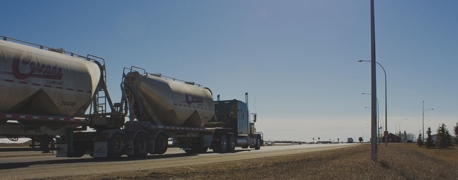Truckers, What's Your Record? New Clearinghouse Rules for CDL Drivers

Hiring competent drivers with clean records is a smart practice for any motor carrier. While verifying an applicant driver’s history used to involve calls to previous employers, it’s now easier to get information regarding past violations thanks to the Drug and Alcohol Clearinghouse. Operated by the Federal Motor Carrier Safety Administration (FMCSA), this online database now includes three years of information about commercial drivers’ drug and alcohol violations.
As of January 6, 2023, motor carriers no longer have to reach out directly to the former employers of applicant drivers to learn of any Part 382 (Controlled Substances and Alcohol Use and Testing) and Part 40 (Procedures for Transportation Workplace Drug and Alcohol Testing Programs) violations. These violations are tracked in the Clearinghouse and can be queried as needed.
The Clearinghouse was created and launched at the beginning of 2020. It took three years for the database to accumulate enough information for carriers and government agencies to use to conduct background checks on CDL holders’ drug- and alcohol-related violations per FMCSA standards.
These violations may include:
- Having a blood alcohol concentration of .04% or greater
- Using any drug specified in Part 40, other than prescribed by a licensed practitioner
- Alcohol use during or within 4 hours of performing a safety-sensitive function
- Alcohol use within 8 hours of an accident or before a post-accident test is completed
- Positive test for certain drugs
- Refusing to submit to a mandatory drug or alcohol test
By October 2022, more than 3 million drivers and 427,000 employers were registered in the Clearinghouse. The database had also accumulated information on 171,957 drug-related violations and about 4,000 alcohol-related violations. Most drug-related violations in the Clearinghouse involved marijuana, which could be attributed to states’ varying stances on the legalization and medical use of marijuana. There were 95,076 positive marijuana tests reported to the Clearinghouse.
Also as of October 2022, 113,995 drivers were in prohibited status. The Clearinghouse tracks when drivers have started and completed the federal return-to-duty process, which may include seeing a substance abuse professional and receiving treatment. Another 42,515 drivers had successfully completed the return-to-duty process and were subsequently given non-prohibited status.
Today, employers must query the Clearinghouse before allowing a current or prospective employee to drive a commercial vehicle on a public roadway. They must also conduct ongoing annual queries of all employee drivers. If these queries turn up results that a driver is in prohibited status, meaning they have unresolved drug and/or alcohol violations reported to the Clearinghouse, the employer must not allow them on the road.
Future Clearinghouse Requirements for State Licensing Agencies
Carrier queries are just the beginning of the Clearinghouse’s full potential. Starting on November 18, 2024, all state driver licensing agencies will be required to complete Clearinghouse queries before issuing, renewing, or upgrading any commercial driver’s license (CDL) or commercial learner’s permit (CLP). Each licensing agency must also suspend or downgrade a CDL or CLP if the Clearinghouse informs them that a driver is in prohibitive status. The idea is that by linking state driver licensing agencies and the Clearinghouse, any drug and alcohol violations will automatically impact a driver’s CDL status.
What Does This Mean for Truckers?
Once a driver is registered in the Clearinghouse, they can access their own record electronically. This record is free for the driver to access and will include any information regarding reported violations and their return-to-duty status, if applicable. They can also give electronic consent to release detailed information about any violations to current or prospective employers.
Truck operators are held to a high standard regarding drug and alcohol use, traffic violations, and overall roadway safety. They operate vehicles that may be carrying hazardous materials or may weigh tens of thousands of tons. There is no room for error, not with the limited maneuverability of massive tanker trucks or tractor-trailers, poor driving conditions, heavy traffic, distracted drivers, and other hazards.
Across the U.S., CDL drivers are prohibited from operating a commercial vehicle with a blood alcohol concentration (BAC) of .04% or greater, which is half of the .08% limit imposed on other motorists. And yet, truck drivers have the lowest rate of alcohol-involved accidents of any category of motorists on America’s roadways.
In 2020, for example, just 3% of large truck drivers involved in fatal traffic accidents had BACs of .08% or greater. That percentage was significantly higher for drivers of light trucks (19%), passenger cars (23%), and motorcyclists (27%).
The Drug and Alcohol Clearinghouse brings another level of clarity and accountability for truck driver violations. Once registered, CDL holder can access their records at any time to ensure their accuracy. They can make sure their return-to-duty progress is tracked appropriately and can take a proactive approach to maintain their license or permit.
Do Drivers Have to Register with the Clearinghouse?
Clearinghouse registration is not mandatory for CDL and CLP holders. Still, they must register to consent to a full query by a current or prospective employer (limited queries are possible if the driver is not registered). Registration is also the only way a driver can view their own Clearinghouse record.
Reporting Violations for Unregistered CDL Drivers
All FMCSA-regulated employers, substance abuse professionals, medical review officers, and third-party administrators are required to report drug and alcohol violations by CDL and CLP holders to the Clearinghouse. A driver does not need to be registered with the Clearinghouse to have a violation entered against them. The employer or other party required to report such a violation will enter the information, along with the driver’s CDL information, in the Clearinghouse regardless of whether the driver is already registered.
Information on drug and alcohol violations will be available in the Clearinghouse for 5 years or once the driver has completed the return-to-duty process. Any violations that occurred before the Clearinghouse was created (prior to January 6, 2020) do not need to be retroactively added to the database.
Clearinghouse Regulations Affect All Commercial Drivers
It isn’t just truck drivers who are affected by Clearinghouse regulations. Any driver or employer of a driver who operates a commercial vehicle may be affected, including passenger carriers, school bus drivers, limousine drivers, waste management vehicle drivers, and any other organizations or agencies that employ drivers who may be subject to drug and alcohol testing regulations.
Beyond this, full implementation of Clearinghouse recording and queries is a significant step in the direction of safer roads for us all—and eventually a future where truck accidents involving alcohol or drugs simply do not happen.


